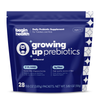Prebiotic vs Laxatives for Kids: What You Need to Know
share this article

When it comes to constipation relief, does your little one need a prebiotic or laxative?
We get this question from families often and we understand that it can be a little confusing.
While prebiotics like our Begin Health Growing Up Prebiotic and laxatives can both help kids poop, there are also many differences between the two.
Is one better than the other, and how can we make the right choice for our kiddos?
In this article, we’re breaking down the key differences between the two to answer your question and determine which one may be better to support overall gut health and may help support symptoms from constipation.
What is a Prebiotic?
Just as a garden requires the right nutrients to cultivate healthy plants, our gut also relies on the right kind of food to support the growth of beneficial gut bacteria.
Prebiotics are a unique type of fiber found in plant foods and play a crucial role in softening stools and facilitating easier passage in kids [3].
Think of prebiotics as the nutritious fertilizer that helps our little one’s microbiome thrive. We can obtain prebiotics through food sources or through a supplement like our Growing Up Prebiotics.
Prebiotics help good bacteria enhance their functionality by providing nourishment.
What’s Different about Begin Health Growing Up Prebiotics?
Our Growing up Prebiotics is carefully crafted with two important ingredients:
- Chicory Root Fiber
-
Chicory Root is a plant that contains a vegetable fiber called inulin, which is found in its roots. Studies have shown inulin can improve stool consistency in constipated children [3].
-
Inulin works to stimulate the growth of good gut bacteria, such as Bifidobacterium to support health [9].
- Human Milk Oligosaccharide:
-
2’FL (2'-Fucosyllactos) HMO is a prebiotic that replicates Human Milk Oligosaccharide, one of the most valuable components of breast milk. Contrary to its name, Human Milk Oligosaccharide is not from human milk.
-
Human Milk Oligosaccharide is a prebiotic with the same molecular structure as the most abundant prebiotic in human breast milk. HMO has been extensively studied for its health benefits, particularly in relation to immunity and development of a healthy microbiome [5].
Together, these two ingredients make up our Growing Up Prebiotics, which provides 3g of fiber per serving.
Prebiotic fiber such as chicory root helps soften stool to support constipation symptoms with easier passage.
With daily use, our prebiotic blend also supports our kids by creating a foundation for a healthy and balanced digestive system [3].
What is a Laxative?
Laxatives are a medication used for the digestive system when things are not moving as smoothly as they should. They promote bowel movements and ease constipation by loosening stools. The type of laxatives will determine how it works in the body, as shown below. Common types of laxatives include:
-
Osmotic Laxatives: draws water into the intestines to soften stool. Examples include Miralax ®, GlycoLax.
-
Stimulant Laxatives: stimulates the nerves controlling the digestive tract muscles to speed up bowel movement. Examples include Dulcolax, Senokot.
-
Emollient Laxatives: creates bowel movements without straining through addition of water to the stool. Examples include Colace.
-
Bulk forming Laxatives: increases the bulk of stool by helping to retain water for easier passing [6]. Examples include Metamucil, Citrucel.
When it comes to considering laxatives, it's always a good idea to consult your kid’s personal pediatrician first to help guide you on the appropriate protocol for your kids.
Laxatives such as MiraLax ® suggest that the product should be used for no more than seven consecutive days, and to consult with a doctor to discuss usage beyond the one week period.
While doctors may recommend a laxative such as Miralax, you can always ask if there are natural alternatives to try for your kid’s constipation relief strategy.
Begin Health Expert Tip
Prebiotics, such as our Growing Up Prebiotics, can be incorporated into daily routines to support your kid’s gut health by providing nourishment to their developing microbiome.
With daily use, prebiotics such as a chicory root fiber helps soften stool for easier passage [3].
Laxatives such as Miralax ® recommend use of an osmotic laxative for no longer than seven days before consulting with a doctor to discuss usage beyond one week.
So which one can support our kid’s long-term gut health, prebiotics or laxatives?
When it comes to promoting long-term gut health, the studies on prebiotics have shown that they can be safely consumed for extended periods [2, 8].
Clinical research on our chicory root fiber demonstrates an increase in stool frequency, a softer consistency, and a decrease in pain, in six weeks with daily consistent use [3].
Laxatives are medications that are intended for occasional use, with the manufacturer’s suggested usage period of one week. It is recommended to consult with a physician prior to extending laxative usage beyond the one-week mark.
Laxatives may have possible side effects that include cramping, dehydration, and electrolyte imbalances so it’s important to only use knowing the possible side effects [7]. Additional side effects of laxatives may include:
- Nausea
- Diarrhea
- Bloating
- Loss of normal bowel function
Furthermore, there is some evidence suggesting that long-term use of stimulant laxatives is associated with muscle loss found in the haustral folds of the colon, indicating that laxative usage may have contributed to these changes [7].
Summary
Prebiotics and laxatives both help with constipation, but prebiotics are safe for daily use in kids, while long-term use of laxatives should be approached with caution and under medical guidance.
For lasting gut health, a balanced diet rich in fruits, vegetables, and prebiotic-rich foods, combined with lifestyle modifications and prebiotic supplementation like Begin Health’s Growing Up Prebiotics, can support regular bowel movements and reduce digestive discomfort.
















